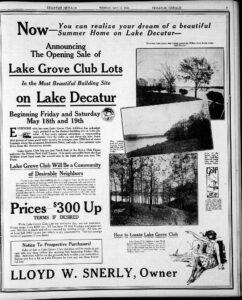100 Years of Lake Decatur History
As you can imagine, there is a lot of history that happened throughout the first 100 years of Lake Decatur’s existence. We will honor that history with weekly posts on the City of Decatur’s Facebook page, and on this page, up until the Centennial Lake Fest in July. Learn more about festivities to celebrate the Centennial at www.decaturil.gov/lakedecatur100/
The weekly posts certainly won’t cover all the history! For additional historical posts, and to share your own, check out our separate Facebook group. If you are unable to upload your pictures/documents online, you can visit the Staley Museum or the Decatur Public Library History Room during regular business hours and they will help with your Lake history submission.
1. Staley Pump House/Club House – 1919
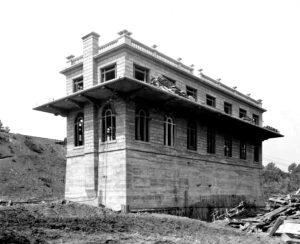
A permanent dam to create Lake Decatur was slated to begin construction in July 1920, but something had to be done immediately. In the fall of 1919, A. E. Staley Sr. was given permission to create a temporary dam and build a pumping station. The Staley Pump House was completed and began operations in 1920.
The lower level, all machinery, pumped water to the Staley manufacturing plant, while the upper level was the Staley Club House. People could reach the clubhouse by boat, train, and boardwalk. A model of the pump house is on display at The Staley Museum.
2. Construction of the dam – 1920
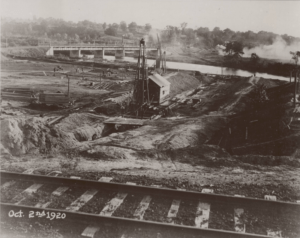

Mayor Charles M. Borchers turned the first shovel of dirt in July of 1920 as the dam construction began. Temporary coffer dams were put in place as part of the process. It’s reported they used 30,000 barrels of concrete to construct the dam before finally being complete in 1922.
The City’s South Water Treatment Plant has an archive of plenty more photos of the dam construction online here. And a short timeline presentation is also available here.
3. 4-Day Celebration & A World-Record Swim – 1923
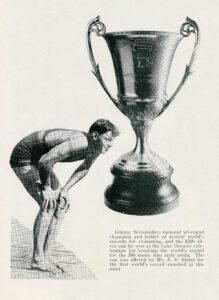
Lake Decatur was filled to capacity during the summer of 1923. The citizens planned a 4-day celebration with fireworks, rowing & boat races, water polo, airplane exhibitions, and more. 25,000 people attended.
July 4, 1923 – Johnny Weissmuller, famed Olympic gold medal winner and original portrayer of Tarzan in film, swam in five races during the day’s series of water sporting events. He won a silver trophy, worth $200 and offered by A.E. Staley Sr., for being the first to break a world record during the contests. Weissmuller lowered the record for the 500-meters in open water to six minutes and fifty-five seconds.
4. “Pageant of the Waters” – 1923


July 5, 1923 – During the Lake Decatur Celebration, a series of short plays was performed called the “Pageant of the Waters.” One was a recreation of the City Council meeting in which they discussed the building of the dam. A.E. Staley was originally slated to play himself, but he was called away to attend an urgent out-of-town meeting, so Staley Mfg. general superintendent G.E. Chamberlain stood in.
Scenes of Abraham Lincoln in Decatur during his campaign were also portrayed.
5. “Venetian Nights” water parade – 1923
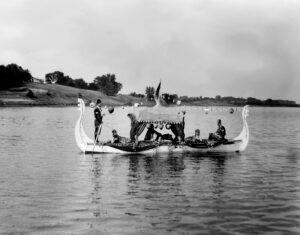
July 6, 1923 – The Decatur Boat Club put together a water parade on July 6th, titled Venetian Nights. 40-50 boats were reported to have participated, and $125 in prizes were given away. G.E. Chamberlain won first prize in the entries for inboard motor boats, and J.B. Fletcher, millwright foreman, won second place in the same category.
6. Bathhouse, Boathouse, Beach House – 1925
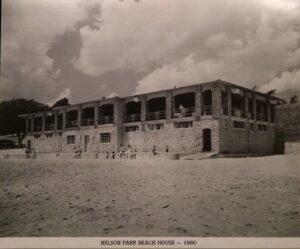
April 1925 – The Decatur Water Supply Company granted boating and bathing rights in the Lake to the Decatur Park District. The rights were extended for 99 years in 1926. However, in 1934 the Decatur Water Supply Co. dissolved, giving the management of the Lake to the City. Thus ended bathing and boating rights. The Park District turned the bathhouse, boathouse, etc. over to the City.
The bathhouse was constructed as a federal Work Progress Administration (WPA) project and currently houses the Beach House restaurant.
7. Sailing, Commodore Decatur Yacht Club – 1936
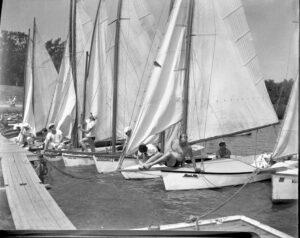
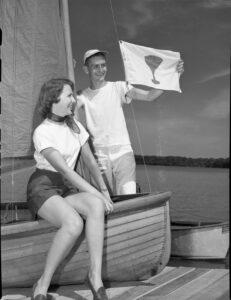
The Commodore Decatur Yacht Club was established in 1936 by a handful of residents who wanted to promote sailboat racing on Lake Decatur. Over the years, regattas were held often, with trophies being presented to winners. Today, most of the boats at the Club are cruiser and cabin boats. Learn more about sailing and the Club at www.saildecatur.org
Sailboat regattas are being planned for the Centennial Lake Fest! Stay tuned for more info on how to participate or when to watch these races.
8. Dam sluice gates, water intakes – 1922
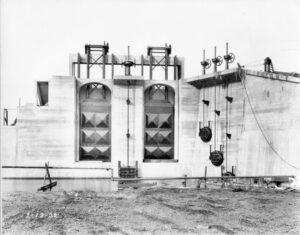
This photo of the newly-constructed dam was taken before Lake Decatur was filled. The photographer was standing on what would soon be the bottom of the Lake covered with 20 feet of water. The photo shows the original dam sluice gates (the tall rectangular panels) and two round water intake covers to the right. When raised, the covers allowed Lake Decatur water to flow to the City’s original drinking water treatment plant located on Lincoln Park Drive.
One of these 101-year-old covers was recently discovered partially buried in the grass adjacent to the dam. It has been refurbished and is now located near the front door to the South Water Treatment Plant.
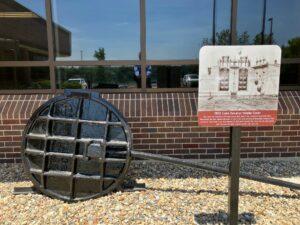
9. Fishing
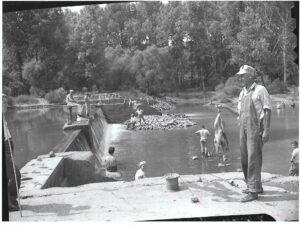
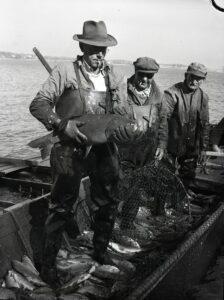
Lots of fishing has occurred over the years at Lake Decatur. Some of the popular bank spots are near the dam, along Lake Front Road between the docks, at the Lost Bridge boat ramps, and the turnaround near Reas Bridge. We are a great spot for flathead catfish, crappie, freshwater drum, white bass, and largemouth bass.
We look forward to hosting a community fishing tournament during the Lake Fest. Stay tuned for more info.
10. Swimming & Other Fun – 1930s
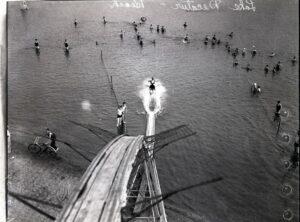
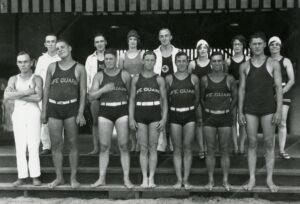
The 1930s sure looked like fun at Lake Decatur…and perhaps a bit dangerous, too?? Thank goodness for life guards!
11. Lake Patrol
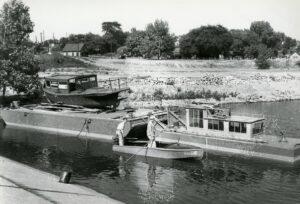
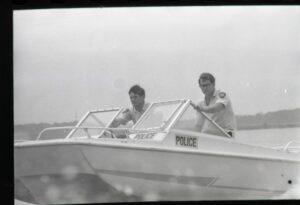
Lake Patrol has served an important purpose over the years, keeping boaters and swimmers safe. In 2022, we recognized two officers who saved a man during the July 4th holiday.
Did you ever work as a Lake Patrol Officer? What a great way to spend a summer!
12. Equipment

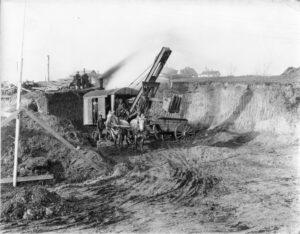
The Lake Decatur dam has an earthen and clay core encased in concrete. In order to more efficiently move the enormous amount of dirt, clay, gravel, concrete, and other construction materials, the dam’s contractor, L. M. Cope & Son, had a railroad spur built. Fascinating to see the equipment used in the 1920s.
13. Lake Grove Club lots – 1923
A 1923 ad in the Decatur Herald for Lake Grove Club. Just a $300 starting price – weren’t those the days!
Now, property/homes around the Lake are prime real estate. But you have to love the beautiful lake houses!
14. Soil & Water Conservation – 1943
From almost the moment Lake Decatur was established, it began filling up again with rich, black earth from the surrounding farmland. By 1946, more than one quarter of the lake’s storage capacity had filled in with topsoil equivalent to 7 inches deep over 3,400 acres. Additionally, the lake had absorbed nearly $100,000 in available nitrogen and another $50,000 worth of phosphorus (1946 prices) that was intended to help produce crops.
Concerns of silting prompted City leaders to start an Upper Sangamon Valley Conservation Service in 1941 which later expanded to the Macon County Soil & Water Conservation District, established from a 1943 referendum passed by Macon Co. residents. The district immediately began encouraging farmers in the Lake Decatur watershed to use conservation practices to prevent erosion and protect their farmland. More on conservation efforts coming in future posts. Learn more from this 2004 publication.
15. Lake Springer?
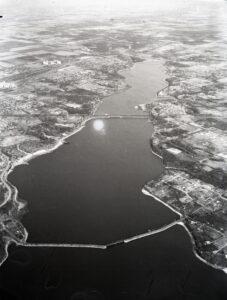
This 1953 aerial photo shows Lake Decatur. Around this time, options were being discussed to prolong the lake’s longevity and increase additional water supply. Removing sediment from the lake to increase storage capacity would be 12x more expensive than building new reservoirs. So the City turned its efforts toward creating a new lake near Oakley: Lake Springer.
However, in the 1960s, political winds were shifting, and public concern was growing over the ecological effects of impounding natural streams and rivers to create reservoirs/lakes. While Decatur had support in Washington and Springfield when it began planning Lake Springer, regulatory changes and opposition from interests upstream doomed the project.
16. A Sailor Returns!
The August 1951 edition of the Staley Journal features an article on members of the Commodore Decatur Yacht Club that were also Staley employees. One person mentioned in this, Bill Buckles (13 at the time), is returning to Decatur (from Ohio) for the regatta! What a cool homecoming!
Regattas during the Centennial Lake Fest will be 12 noon to 4pm on July 8, and 10am to 12 noon on July 9. Come watch some great sailboat racing!
17. Dredging
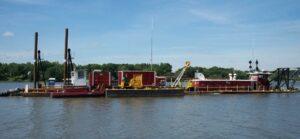
To preserve Lake Decatur’s storage capacity, dredging sediment from the lake has been necessary. Basin 5 was dredged in 1993-1994, and Basin 6 in 2004-2011. The latest, $91-million dredging project for Basins 1-4 began in 2014 and was completed in 2018.
The most recent dredging project increased the lake’s storage capacity by 30% and made Basins 1-4 an average of 4 feet deeper. The sediment was collected in the City’s Sediment Basin in Oakley Township. Learn more
18. Thank you!
Thank you for joining us to honor the history of our lake! You can continue to share your history in the public Facebook group “100 Years of Lake Decatur History.” Also, consider visiting the Staley Museum to learn more about A.E. Staley’s influence on the creation of the lake, or check out more archived photos at the Decatur Public Library’s History Room.

